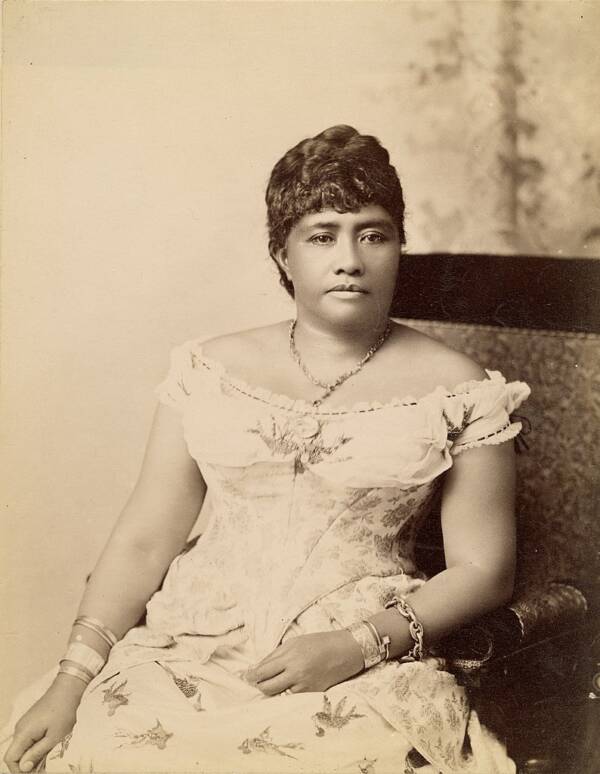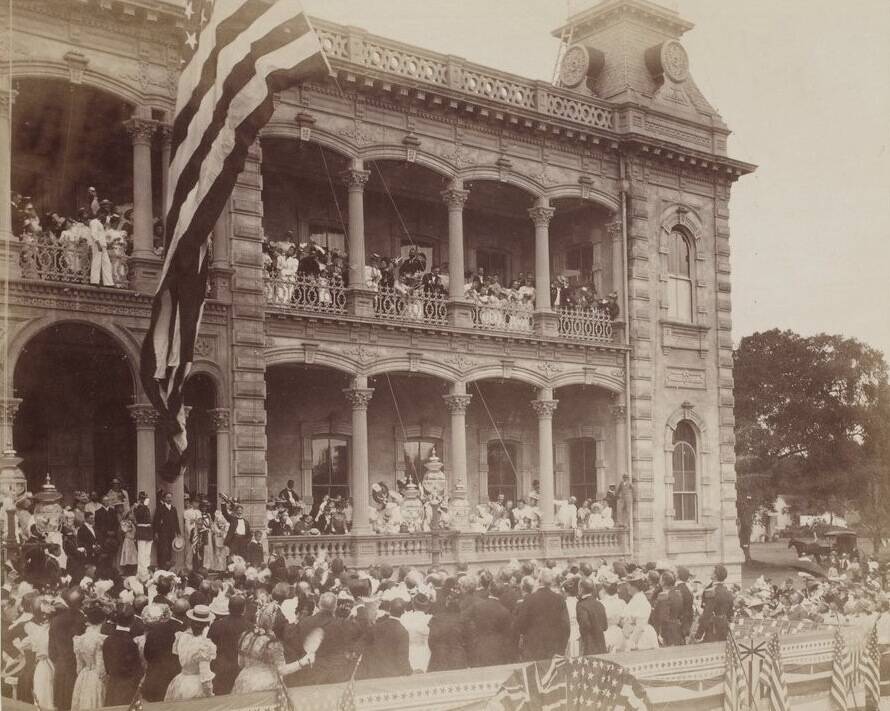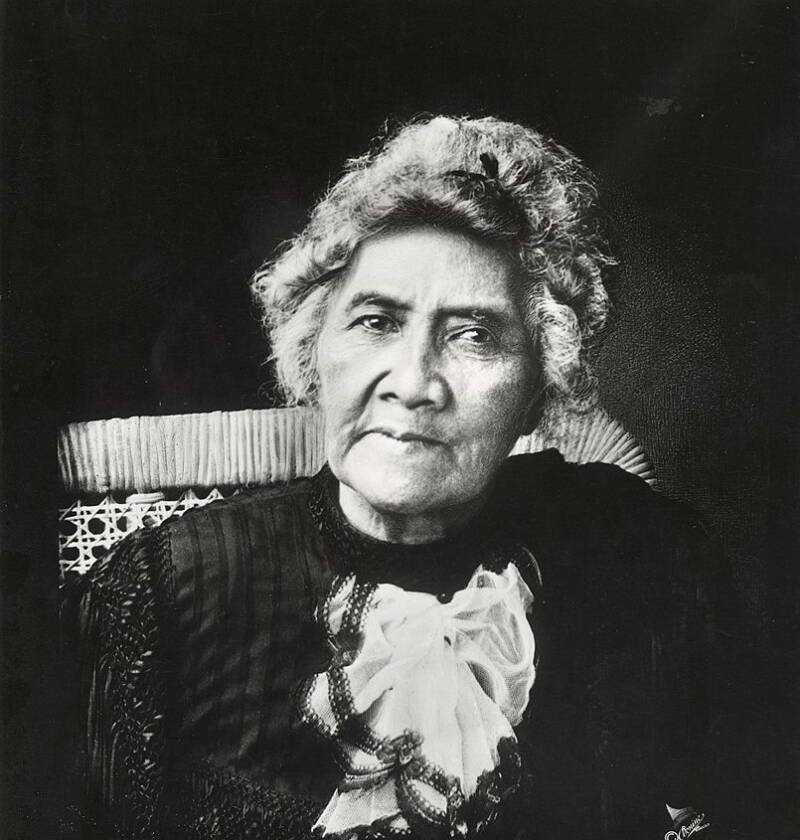After ascending the throne in 1891, Queen Liliuokalani began working to draft a new constitution and ensure Hawaiin sovereignty — only to be overthrown by U.S. business interests.
When Queen Liliuokalani ascended to the throne of the Kingdom of Hawaii in 1891, she became the first female ruler of the Hawaiian monarchy — and its last-ever sovereign monarch. Unfortunately, she came to power when powerful American business interests were looking to control the islands for their own profit and convinced the U.S. government to help them do it.
Though the Hawaiian queen didn’t go down without a fight, her battle against the American sugar planters to maintain Hawaii’s independence saw her overthrown, put on trial for treason, sentenced to five years of hard labor, and forced to watch helplessly as the U.S. forcibly annexed the entire island chain as an American territory.
Who Was Queen Liliuokalani?

Unknown/Library of CongressA signed photograph of Queen Liliuokalani.
Born Lydia Liliʻu Loloku Walania Kamakaʻeha on September 2, 1838, Liliuokalani grew up in one of Hawaii’s elite native families. Before becoming crown princess, Liliuokalani went by Lydia Kamekaeha. Lydia’s mother, Keohokalole, advised King Kamehameha III.
In her youth, Lydia traveled the world and maintained a close relationship with the ruling family. In 1874, Lydia’s older brother, Kalākaua, became king. Three years later, Liliuokalani became his heir, the successor to the new Kalākaua dynasty that ruled over the Hawaiian kingdom.
As the crown princess, Lydia adopted a royal name, Liliuokalani. In 1881, she acted as her brother’s regent while he toured the world. The crown princess also traveled to Queen Victoria’s Crown Jubilee, meeting with the British monarch and U.S. President Grover Cleveland.
In 1891, when her brother died, Liliuokalani ascended to the throne.

Unknown/Hawaii State ArchivesA photograph of Crown Princess Liliuokalani.
But Queen Liliuokalani ruled during a tumultuous time in Hawaii. American and European businessmen had bought up much of the private land on the islands and these wealthy landowners began pushing for more of a say in Hawaii’s governance.
In 1887, under pressure from foreign businessmen, King Kalākaua had signed the “Bayonet Constitution.” The document, which Liliuokalani opposed, limited the monarchy’s power and by standing against increased privileges for the United States — including control over Pearl Harbor — Liliuokalani angered American businessmen even before becoming queen.
As queen, Liliuokalani pushed for a new constitution to strengthen the independence of the monarchy and, in response, wealthy businessmen began plotting a coup against her.
In The 19th Century, Sugar Ruled Hawaii
Sugar was Hawaii’s major cash crop by the time Queen Liliuokalani took the throne. For decades, Hawaii had been a major sugar producer, but new industrial methods and larger plantation-style farms increased the crop’s role in Hawaii’s economy.
From 1866 to 1879, sugar production skyrocketed by 250%. By the 1890s, industrial sugar plantations often employed a thousand workers. The Hawaiian Commercial and Sugar Company, located on Maui, produced 12,000 tons of sugar in 1890.
American and European business owners bought up land and expanded sugar plantations, consolidating power in the kingdom.

Jules Tavernier/Horikawa Fine Art, HonoluluAn 1885 painting showing a Maui sugar plantation.
In 1890, the U.S. passed a tariff act that hit Hawaii’s sugar producers hard. Hawaii previously benefited from low tariff rates, but the act raised the cost of Hawaiian sugar and the new law nearly destroyed Hawaii’s industry.
Hawaii’s sugar owners came up with a plan to save their industry: they would overthrow Queen Liliuokalani and push for the U.S. to annex Hawaii. Once under U.S. rule, Hawaii’s sugar producers would no longer pay tariffs.
The Coup That Ended Hawaii’s Monarchy
Queen Liliuokalani had battled against the powerful plantation owners as crown princess and as monarch, but she was powerless to stop the U.S.-backed coup to overthrow her kingdom in 1893, led by American businessman Sanford Dole.
In January, a secret “Committee of Safety” made up of foreign sugar planters met near the Iolani Palace. The U.S. government backed the coup attempt with 300 marines to shield the planters as they seized power.
When the militia stormed the palace, Queen Liliuokalani surrendered, hoping to avoid bloodshed. The Committee of Safety created a provisional government and put Dole in charge.

Gabriel Bertram Bellinghausen/Wikimedia CommonsIolani Palace, where Queen Liliuokalani ruled and served her house arrest.
Publicly, President Cleveland opposed the coup. But the Committee of Safety ignored Cleveland’s objections and established the Republic of Hawaii, making Sanford Dole its president.
But Queen Liliuokalani refused to cede power without a fight.
The Republic Of Hawaii Turns Against Queen Liliuokalani
In 1895, the deposed Queen Liliuokalani led a counter-revolution to restore the monarchy. But against the power of the Republic of Hawaii and its wealthy backers, the insurrection failed.
Instead, the republican government arrested Liliuokalani and put her on trial for treason. During her trial, Queen Liliuokalani denied planning the counter-revolution. Still, the court found her guilty and sentenced the former queen to five years of hard labor.
The court later commuted the sentence to house arrest, restricting Liliuokalani to a single bedroom in the Iolani Palace.

Unknown/Hawaii State ArchivesQueen Liliuokalani sitting next to Sanford Dole in 1914.
In exchange for a pardon, Liliuokalani also signed a statement yielding to the United States. “Now, to avoid any collision of armed forces and perhaps loss of life,” Liliuokalani wrote, “I do, under this protest, and impelled by said forces, yield my authority.”
The formal abdication of Queen Liliuokalani didn’t end her role in Hawaii, however. Under President Dole, the Republic of Hawaii sought annexation by the U.S., which Liliuokalani opposed.
The United States Annexes Hawaii
In 1897, the U.S. Senate considered a treaty to annex Hawaii. But a group of native Hawaiians, led by Queen Liliuokalani, blocked the treaty. After lobbying senators, the treaty died.
But the Spanish American War reignited the effort to annex Hawaii. The new imperialist-minded president William McKinley declared Hawaii the perfect refueling station for the Pacific fleet. Plus, McKinley reasoned, Pearl Harbor would make a good naval base.
With war on their minds, Congress passed a joint resolution to annex Hawaii.

Unknown/Bibliothèque Nationale de FranceThe flag exchange at Iolani Palace after the U.S. annexation of Hawaii.
Native Hawaiians largely opposed the annexation, as did Queen Liliuokalani. But the move pleased Hawaii’s businessmen and sugar planters. Sanford Dole transitioned from President of the Republic of Hawaii to the territory’s governor.
The Queen’s Legacy in Hawaii
Queen Liliuokalani never regained her throne. With Hawaii as an American territory, the sugar planters who overthrew the Hawaiian monarchy paid lower taxes. Liliuokalani withdrew from public life and died of a stroke in 1917.
To this day, Liliuokalani remains the last sovereign of the Hawaiian kingdom.

Robert K. Bonine/Hawaii State ArchivesA portrait of Queen Liliuokalani two years before her death in 1917.
In 1993, Congress officially apologized for participating in the coup against Queen Liliuokalani. As the apology acknowledged, “the native Hawaiian people never directly relinquished to the United States their claims to their inherent sovereignty.”
However, Hawaii still remembers its last queen. In fact, one of Hawaii’s most popular songs, “Aloha Oe,” was composed by Liliuokalani herself. The queen wrote the song, also known as Farewell to Thee, after seeing lovers part on Oahu in 1877. Queen Liliuokalani’s parting words in Aloha Oe were, “until we meet again.”
Queen Liliuokalani’s fight against annexation was only one chapter in the long history of Hawaii’s relationship with the United States. Then check out the history of Niihau, Hawaii’s forbidden island.




